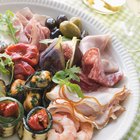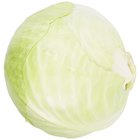
Pita bread, also known as pocket bread, is Middle Eastern flatbread. A good choice for making sandwiches, you can cut the round pita in half and fill the pocket with savory ingredients. You can also top the whole pita bread and wrap the edges around the filling. It's a versatile bread in terms of use and taste.
Beef
From leftover hamburger to roast beef, you can incorporate beef in many ways into a pita sandwich. Crumble leftover hamburger into the pita pocket with lettuce, onion, tomato and mayonnaise for a classically flavored sandwich. Layer roast beef, honey mustard, red onion, Swiss cheese, Romaine lettuce and Roma tomatoes in a pita to create a sweet and tangy meal.
Chicken
Whether it’s home-cooked or from a package, shredded chicken breast is versatile ingredient for pita sandwiches. Mix the chicken with soy sauce, rice vinegar, water chestnuts, baby corn and bok choy cabbage together and stuff into a pita for a quick sandwich with a Asian flair. Combine chicken, barbecue sauce, onions, beans and corn and stuff in a pita pocket for a Southwestern-style sandwich.
Pork
Tasty pork brings protein to the pita sandwich. Wrap pork, Dijon mustard, green onions, celery and tomato in a pita to create a tangy wrap sandwich with a little crunch. Layer thinly sliced pork, mango salsa, pineapples and red onion for a pita sandwich with a tropical twist. Combine shredded pork, tomato sauce, red pepper and chipotle pepper in a pita for a smoky flavored meal with a peppery bite.
Tuna
Tuna canned in water is a healthy way to turn a plain pita into a filling sandwich. Stack drained tuna, tomato, lettuce and avocado in the pita pocket for a simple sandwich with plenty of flavor. Wrap drained tuna, mayonnaise, mustard, onions, celery, parsley and walnuts in a pita for a creamy wrap sandwich.
Turkey
Turkey, a classic sandwich meat, makes quick use of deli meats or leftovers. Layer peppered turkey cold cuts, cheddar, lettuce, onions, brown mustard and mayonnaise in a pita pocket for a traditional meal. Stuff shredded turkey, dried cranberries, celery and onions into a pita for a Thanksgiving-style sandwich or to use up leftovers. Combine turkey pastrami, honey mustard, lettuce, cucumbers, avocado, tomato and onions in a pita pocket to create a colorful sandwich with sweet and spicy flavor.
Vegetarian
You don’t need meat to create a filling and flavorful pita sandwich. Layer tomatoes, cucumbers, green bell peppers, red onion, radishes and feta cheese in a pita pocket for a Greek-style meal. Combine soaked bulgur wheat, parsley, green onion, garlic, lemon juice, and olive oil to create a Middle Eastern tabbouleh mixture to stuff in a pita pocket. Stuff the pita with tomatoes, olives, onions, celery, cucumber, and mozzarella cheese for an Italian-inspired sandwich.
Related Articles

How to Make Pasteles

Pairing With Coconut Rice
What Goes Well With BBQ Shredded ...

Freeze-Ahead Meals With Pork Chops

Ideas for Smoked Gouda

How to Cook Barbecue Deer Meat in a ...

How Many Calories in Chopped Antipasto ...

What Kind of Food for a Hawaiian Themed ...

Ideas for Cooking Boston Butt Strips

Ways to Eat Kidney Beans
Easy Chicken Tortilla Soup Recipe

What to Do With Leftover Boiled Cabbage

What Kind of Dinners Can I Make With ...

How to Cook Chicken Tournedos

Dinner Ideas With Chicken & Cream of ...

How to Make Asado Chinese Style

How to Cook Chinese Lettuce

How to Cook Fresh Turnip Greens
Cooking Ideas for Beef Sirloin Top Butt ...

Meals With Garlic Bread
References
- The Deluxe Food Lover's Companion; Sharon Tyler Herbst and Ron Herbst
- Food & Wine: Greek Salad With Bulgur in Pita Pockets
Writer Bio
A writer since 2000, Aya Pauli has covered a variety of topics including food, fashion, beauty, health, parenting, education, decor and crafts. Her award-winning recipes have been published in food magazines such as "Taste of Home," and she is also the author of a salad cookbook. Pauli's craft projects appear in major manufacturer websites, including Dow Styrofoam. She also holds a CDA in early childhood education and works as a preschool teacher in Wyoming.
Photo Credits
Jupiterimages/liquidlibrary/Getty Images